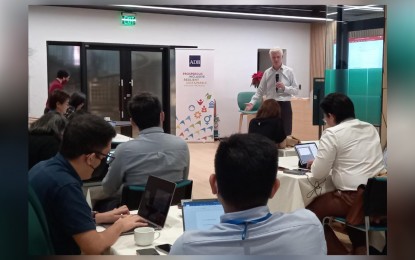
HIGHER GROWTH. The Asian Development Bank (ADB) revised higher its 2022 growth forecast for the Philippines to 7.4 percent from 6.5 percent previously due to continued expansion of the domestic economy, ADB Country Director for the Philippines Kelly Bird said. The lender, however, slashed its 2023 growth forecast from 6.3 percent to 6 percent due to the impact of the higher interest rate, elevated inflation and expectations for slower growth of advanced economies. (Photo by Joann Santiago-Villanueva)
MANILA –The Asian Development Bank (ADB) hiked its 2022 growth forecast for the Philippines to 7.4 percent following the higher-than-expected output in the first three quarters of this year, but slashed its 2023 projections.
The Manila-based lender revised its 2022 growth forecasts from the previous 6.5 projection but the 2023 forecast was adjusted to 6 percent from 6.3 percent. These figures are included in the latest supplement of the lender’s Asian Development Outlook (ADO) 2022 released on Wednesday.
In a briefing on Wednesday, ADB Country Director for the Philippines Kelly Bird attributed the change in this year’s gross domestic product (GDP) projection to the around 7.6 percent actual output in the first three quarters of the year, which exceeded the government’s 6.5 to 7.5 percent full year growth assumption.
The economy posted an annual growth of 8.2 percent, 7.5 percent and 7.6 percent in the first to third quarters this year, respectively.
“The Philippine economy has shown strong underlying growth momentum and resilience in 2022 and this is expected to continue in 2023, with GDP growth converging towards its longer term growth rate of about 6 percent,” Bird said.
The ADB official traced the reduction of their 2023 growth output forecast for the domestic economy to the impact of elevated inflation, higher interest rates and the sharper-than-expected slowdown of advanced economies.
He said upticks of the rate of price increases not only worry monetary authorities but the consumers as well since it negatively impacts on the latter’s purchasing power.
Domestic inflation rate rose to 8 percent last November from 7.7 percent in the previous month.
The latest inflation print is the highest since November 2008, bringing the year-to-date average to 5.6 percent, above the government’s 2 to 4 percent target band.
Inflation rate surpassed the target band since last April given the impact of higher global oil prices as a result of the Russia-Ukraine conflict.
The higher interest rates, which is the result of central banks’ monetary policy decisions to help tame inflation upticks, is also expected to hit private investments, which will hamper strong economic growth.
Amidst these challenges, Bird said the implementation of the various infrastructure projects serve as a catalyst for domestic growth, noting the current government’s bid to continue the increase in infrastructure investments.
He said the higher infrastructure spending “placed the Philippines in a very good position to be able to maintain growth for the next two to three years.”
Bird also cited the continued improvement in the labor sector, which is expected to be sustained until next year.
Philippine Statistics Authority (PSA) data show that the employment rate in the country rose to 95.5 percent last October from the previous month’s 95 percent, and this is estimated to be the highest since January 2020.
Unemployment rate during the same period declined to a pre-pandemic level of 4.5 percent and the labor force participation rate (LBPR) is at 64.2 percent, up from year-ago’s 62.6 percent.
Bird said the continued recovery of the domestic economy has real underlying factors, not just simple pick-up in demand as the economy reopens.
He said the manufacturing sector continues to post improvement as shown by the rising production index in recent months.
Bird said growth of remittances from overseas Filipinos remains strong, citing that while the peso depreciated against the US dollar, its peso value grew, which means increased spending capacity for the remittance beneficiaries.
These underlying growth factors are expected to fuel growth not just this year but in two to year years, and allow the domestic economy to move towards its long term growth potential. (PNA)
